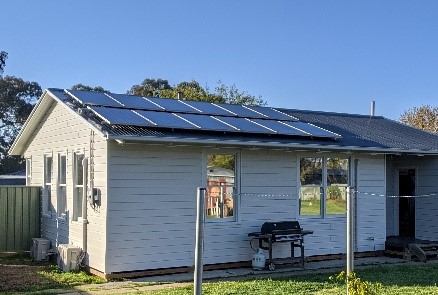By Jason and Danielle
1. Brief outline of your situation:
- Family of 3.
- First purchased home together upon settling in Australia.
2. Description of home/project:
- Renovation and retrofit of suburban house on ¼ acre block.
- Typical weatherboard kit home – 3 bedrooms, 1 bathroom, approx 80m2 living area.
- Facing east/west.
- Purchased in 2019. Came with 3kW solar on the roof. All appliances were 100% gas.
3. Reasons, motivation behind project:
- We are eco conscious and believe in making as little impact as possible.
- Long term it makes financial sense to choose eco alternatives, especially if having to redo big-ticket items (as we did).
- To be a role model for what’s possible.
4. Selection process/criteria used in choosing – block, designer, builder, existing home.
- Affordability – We’d both experienced significantly restrictive home ownership debt in the past and it was a goal not to repeat this if possible. Thankfully Wangaratta had a lot of lower-priced homes in 2019 when we purchased.
- Improvability – Something we could work with – both in terms of affordability and accessibility. Being a small weatherboard house, it’s really easy to do stuff to ourselves, and being cheap we can afford to get someone else to help when needed.
5. Design specifications, priorities:
- Everything we do is functional, efficient, and within our means financially.
- Items are maximum efficiency given its required duty (if it doesn’t get used as much, then it doesn’t really need to be the most efficient model). This is a more realistic and affordable approach for us to take.
6. Features & Materials selected & why?
During our renovations, we’ve focused on the following big-ticket items:
- Flooring – We chose to cover our original timber floorboards to reduce maintenance and heat loss. We decided on a Laminate flooring (cut to size and clips together) from Bunnings (cheapest supplier for reasonable quality) and used a thick, recycled-plastic underlay to reduce heat loss through the floor. We installed this ourselves and, while certainly not a pro job, are pleased with the result.
- Insulation – We have insulated the ceiling and under the floor to increase thermal efficiency. We decided on Greenstuf R2.0 Underfloor by Autex due to its resistance to rodents, longevity, ease of installation, and is made from recycled materials. We already had some insulation in the ceiling, but we added R4.5 EarthWool bringing it to a total of approx. R6. The result? The heat setting on our RCAC went from 22 down to 20 degC with the same level of comfort. Since then, we’ve come to know our house and its thermal capabilities better and operate our RCAC at 19 degC by using our ceiling fan in Summer mode (contradictory, but it forces hot air onto the cold mass of floor which significantly increases heat distribution).
- Smart Devices – To improve functionality and efficiency, we invested in a Sensibo which allows WiFi control of any wall-mounted RCAC and has built-in temperature and humidity sensors.This allows us to monitor temperature and set schedules to increase the RCAC unit temperature based on external weather and the actual temperature of the house. We can set smart schedules so that the house can be warmed / cooled in cheaper energy times, and can be switched on remotely to heat/cool our home in preparation for return from a trip away (we can activate while driving to pre-warm / cool the house before we arrive). We are now converting our ceiling fans to smart WiFi (you can buy a kit from Bunnings for any fan) to allow us the same level of functionality, as we note a significant improvement in winter of house heating using fans with the RCAC’s.
- Heating & cooling – Heating originally consisted of a single gas-operated heater which was replaced with high-efficiency reverse-cycle air conditioners (RCAC). We have three 2.5kW Mitsubishi Heavy units, purchased from Bunnings and installed by local tradespeople, which easily do the job. The best thing is that, while the sun is shining, our heating/cooling is free as the energy produced by our solar more than offsets consumption by the RCAC’s. This is confirmed by going through our hourly usage/generation data which anyone can do through Ausnet here: (https://www.ausnetservices.com.au/en/myHomeEnergy/Login). They really are that efficient.
- Window Furnishings – To further increase heat retention in winter, and omission in summer, we installed a dual-climate thermal window tinting by 3M (LE20 – https://multimedia.3m.com/mws/media/1704897O/le-20.pdf) on our timber sash windows. We investigated replacement with dual-pane aluminium windows, but the look and cost didn’t suit us. Tinting came in at 1/6 the cost with, what we believe, are sufficient thermal benefits compared to the new windows. Plus we now have more privacy (the tint we chose is mirror finish), and our curtains, flooring, and furniture will last longer now that the solar intensity is reduced. We also installed blockout curtains that are specifically installed so that they “hug” the windows – letting less heat out and less light in from street lamps.
- Cladding – This year we finally got the cladding redone and decided to install vinyl weatherboards after considering 3 options – repair and paint, replace with colorbond, and adding vinyl weatherboards. Vinyl weatherboards won for three reasons:
1) Cost – cheapest option overall.
2) Good thermal benefit for the price.
3) Less waste. Since the vinyl is simply applied over the top of the existing weatherboards, there is virtually no waste. And it never needs to be painted ever again. Acting like a second skin, we think that the vinyl weatherboards have made our house a little warmer in winter, and we’re predicting significantly cooler indoor conditions during summer.
- Water heating – We replaced our instantaneous gas hot water system (HWS) with a heat pump (HPHW). Since this is the single biggest user of energy in a house, we splurged and purchased the “Rolls Royce” model- a Sanden – which is manufactured both in Australia and in Japan, and uses an ultra-low impact refrigerant (CO2). It also has no booster element and relies solely on the heat pump, which makes a big difference in energy consumption (the heat pump is 6x more efficient at generating heat https://www.sanden-hot- water.com.au/how-a-sanden-heat-pump-system-works ). So long as the sun is shining our hot water costs nothing to make, as the energy usage is 100% offset by our solar panels. The unit has a built in timer so it only turns on from 2-5pm (peak solar generation) to ensure this is the case as much as possible.
- Appliances – As they need replacing, we choose the most energy-efficient devices we can. The most significant replacement has been our original gas stove and oven with a combination induction/electric. I picked up both appliances at a discount (oven is a secondhand Ariston and Induction cooktop is a damaged-box Aldi) so the purchase cost was minimal. But the savings have been significant. In converting to electric, we were able to disconnect from gas (we no longer have a meter in our yard) so we don’t pay a connection fee – the highest cost on our gas bill. In fact we believe that we now pay, on average, less for electricity than we used to pay in gas connection fees! As for the devices, the induction is amazing. Almost instant heat and easy to use. And the oven is high-efficiency compared to the old one too.
- Smaller cost changes:
– Draught sealing – We have timber sash windows in a weatherboard house on stumps. Needless to say there are lots of gaps! We use fixed draught stoppers on external doors and I used a forward located infra-red (FLIR) camera that plugs into my smartphone to locate “hidden” sources of cold ingress which I have patched up with gap filler.
– Reuse vs. Replace – We’ve made an effort to repair and reuse many features of the house rather than replace. While not as pretty as new stuff, it means that we’ve reduced waste to landfill and saved a lot of money. Our kitchen is still the quirky original design with many of the original cupboard doors, sink, and rangehood. Damaged parts were repaired and replaced only as needed. We painted our very worn bathtub rather than replace. 3 of the 8 doors are still the original ones (the others were either missing or too badly damaged).
7. Data & Cost analysis – eg energy consumption, generation & cost:
We have a full electric home and, for 2.5 people, import 4kWh per day from the grid averaged over the last 12 months. I’m told that is very, very low compared to the current average household consumption (and the average house uses gas)!
8. Challenges, lessons learned, positive & negative outcomes
The outcomes have been nothing but positive for us and the environment. We have a very comfortable home with no sacrifices. And it’s very efficient.
A challenge when it comes to options is: “You only know what you know”. Talk, even to salespeople, as there are an increasing number of people that care about positive outcomes in the sustainable housing realm. I didn’t think about heat pump hot water to begin with, but am very glad I found out about it during the course of my searching.
9. Recommendations / tips:
Focus on the big ticket items first and consider doing it ASAP as the cost benefit will come quickly – especially if you have solar installed.
1. Get solar (if you don’t have it)
2. Insulation
3. Hot water
4. Heating / cooling
5. Cooking appliances.

